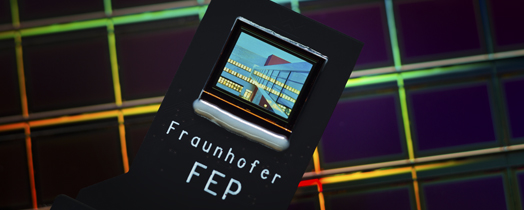03 | 2015 – Videos Controlled by Eye Movement – New Generation of Microdisplays
Diving into a new virtual world and taking part in films by eye control – all this might be possible with a new SVGA-OLED microdisplay. The Fraunhofer Institute for Organic Electronics, Electron Beam and Plasma Technology FEP has been working for a long time on the development of OLED microdisplays combining display and camera functions. The latest work will be presented by scientists at the Hannover Messe (13th – 17th April 2015, booth of TU Dresden – CFAED, hall 2, booth A38).
The world of the so-called wearables is colorful and versatile: Wrist band measuring the pulse, buttons, which indicate the receipt of e-mails with color change or glasses providing information about the environment. Already in 2012, Fraunhofer FEP presented a pair of glasses which enables a normal perception of the environment and, at the same time, offers the possibility to get digital information projected directly into the user’s field of view, which can even be controlled by eye movement. Thus, for example a technician is able to read a manual while working and scroll pages with his/her eyes without interrupting activities. This is possible with a so-called bidirectional OLED microdisplay, which is a display element that includes an embedded image sensor. The sensor can record the user’s eye movement with this integrated camera and thus enables an interaction with the displayed information.
A full-color OLED microdisplay has now been developed by the scientist where the display as well as the integrated camera functions have SVGA resolution (800 × 600 × RGBW).
Bernd Richter, Head of Department “IC and System Design”, where the new display has been developed, describes the new features: “The new generation of bidirectional microdisplays represents a quantum leap in many ways. All essential key parameters of the chip could be improved significantly. This includes an increased resolution of the display and the image sensor as well as an enhanced color depth and the integration of further important components directly into the microdisplay chip. Following this the microdisplay can be operated with significantly fewer external components and thus contributes to further development of miniaturized and efficient systems.”
To ease customers the entry in these new technology the scientists offer development kits in various configurations. The new microdisplay can be transferred directly into product-specific applications. Moreover, fast and cost-efficient customer-specific adaptations and further developments towards innovative microdisplays are possible, which are based on an efficient design methodology of the Si-CMOS backplane circuit.
A part of the work was financed by the Federal Ministry of Education and Research (BMBF) (project ISEMO, funding code: 16SV3682) and by the Fraunhofer-Gesellschaft.
Download the press release and picture
 Fraunhofer Institute for Electron Beam
Fraunhofer Institute for Electron Beam